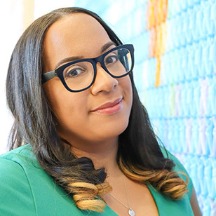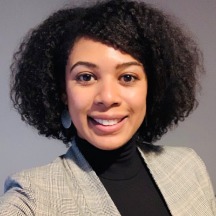Four young Black women in STEM (science, technology, engineering, and mathematics) came together to talk about being the intersection of Black and female as they travel life’s road. Critical Race Theory (CRT) legal scholar Kimberlé Crenshaw is often credited with coining the term intersectionality to create a framework to understand the unique experiences of Black females in the United States.
The four young women added being young and being a first-generation college graduate to the roundabout during the Women of Color in STEM online talk sponsored by the Presbytery of Baltimore. From the lively presentation, it also became clear that mistaken identities and low expectations continue to be landmarks on the maps of American Black life.
All of the women, whom have at least a master’s degree, said that delayed gratification has been the necessary driving speed in their lives.
Jamie Wilkins, Pharm D (A Doctor of Pharmacy) Head, Risk Management Center of Excellence, Worldwide Safety Pfizer Pharmaceutical Company, recalled being told, “You are too young to be in this position.” Christina Dunbar, Senior UX (User Experience) Researcher – Google, added her age and being a first-generation college graduate presented challenges she had to also navigate.
“I was not the most tech savvy person going into college,” says Dunbar, who initially focused on a career in medicine, until she took organic chemistry. “That is the weed out (class),” she smiled. She continued to cruise past careers from pre-law to social work until she decided to take a U-turn to her interest in a computer interaction program. “It bridges the gap between the social sciences and technology that solves real world problems for people,” she explained.
Unlike Dunbar, Wilkins and former Port of Harlem editor Elizabeth Banks, MD, Assistant Professor, Clinical OB/GYN Penn Medicine, started moving down their career paths during their tricycle years. “Tornado warnings were something that caught my eye even in elementary school,” quipped Wilkins.
Much of Banks focus is on relieving pelvic pain, which she says too many doctors often falsely tell women is natural. “Being a woman that is able to help other women is magical to me,” she continued.
Banks says attending a STEM magnet high school along with outside research in hospitals and volunteer work “really confirmed my (childhood) interest in the area.” Today, she added, that being only one of the two percent of doctors who are Black and female and being young often leads patients and colleagues to mistake her as still a student or the person who is cleaning. “Not discounting any of those professions, but that is not just what I do,” she says.
Young Black Women in STEM Discuss Their Real Life Experiences with the CRT Term: Intersectionality




All of the women, whom have at least a master’s degree, said that delayed gratification has been the necessary driving speed in their lives. For Banks, it meant taking a longer route to creating a family. Nevertheless, she adds, even with spend bumps and now having settled into my career, “having a very demanding work schedule and taking care of a child,” has its challenges. Luckily for her and her husband, a cardiologist who had completed his fellowship in a separate city, they were “blessed to find a job in the same health care system” and town.
Banks became the first in her hospital to provide minimally invasive GYN surgery, a relatively new field. Much of her focus is on relieving pelvic pain, which she says too many doctors often falsely tell women is natural. “Being a woman that is able to help other women is magical to me,” she continued.
Critical Race Theory (CRT) legal scholar Kimberlé Crenshaw is often credited with coining the term intersectionality which she created as “remedial education for judges."
Historically Black Morgan State University undergraduate alumnus Kaylin Moody, Engineer, Johns Hopkins Applied Physics Lab, says attending Historically White Johns Hopkins for graduate school had its challenges, too. The schools are both in Baltimore city, but “Morgan State vs. Johns Hopkins culture is very different,” she says.
During her first semester steering around the culturally different Hopkins landscape, she had a grade crash. “I did probably the worst I have ever done in school,” she says.
Her advisor provided Moody the mentoring she needed to “stick it out.” All of the participants valued their mentors, many whom were White. Banks also suggested seeking out podcasts.
When looking for internships, Moody added, “You can try going to the National Association of Black Engineers Conference or maybe the college fair at your school or just asking with one of your professors.”
The Presbytery of Baltimore sponsored the talk to highlight the intersectionality of being Black and female during Women’s History Month. Critical Race Theory (CRT) legal scholar Kimberlé Crenshaw is often credited with coining the term intersectionality which she created as “remedial education for judges.”
She explains, “What happens to Black women isn’t the sum total of what happens to Black men and White women. It’s different and sometimes it requires a different approach.” Wilkins, Dunbar, Banks, and Moody’s paths show that their trek through life are not just the addition of Black plus female, but the unique intersection of the two at a roundabout of Black and female.
Banks became the first in her hospital to provide minimally invasive GYN surgery, a relatively new field. Much of her focus is on relieving pelvic pain, which she says too many doctors often falsely tell women is natural. “Being a woman that is able to help other women is magical to me,” she continued.
Critical Race Theory (CRT) legal scholar Kimberlé Crenshaw is often credited with coining the term intersectionality which she created as “remedial education for judges."
Historically Black Morgan State University undergraduate alumnus Kaylin Moody, Engineer, Johns Hopkins Applied Physics Lab, says attending Historically White Johns Hopkins for graduate school had its challenges, too. The schools are both in Baltimore city, but “Morgan State vs. Johns Hopkins culture is very different,” she says.
During her first semester steering around the culturally different Hopkins landscape, she had a grade crash. “I did probably the worst I have ever done in school,” she says.
Her advisor provided Moody the mentoring she needed to “stick it out.” All of the participants valued their mentors, many whom were White. Banks also suggested seeking out podcasts.
When looking for internships, Moody added, “You can try going to the National Association of Black Engineers Conference or maybe the college fair at your school or just asking with one of your professors.”
The Presbytery of Baltimore sponsored the talk to highlight the intersectionality of being Black and female during Women’s History Month. Critical Race Theory (CRT) legal scholar Kimberlé Crenshaw is often credited with coining the term intersectionality which she created as “remedial education for judges.”
She explains, “What happens to Black women isn’t the sum total of what happens to Black men and White women. It’s different and sometimes it requires a different approach.” Wilkins, Dunbar, Banks, and Moody’s paths show that their trek through life are not just the addition of Black plus female, but the unique intersection of the two at a roundabout of Black and female.
Advertisers | Contact Us | Events | Links | Media Kit | Our Company | Payments Pier
Press Room | Print Cover Stories Archives | Electronic Issues and Talk Radio Archives | Writer's Guidelines






